Acoustical Control with Gypsum Board
New products meet higher standards with less work
![]() Continuing Education
Continuing Education
Use the following learning objectives to focus your study while reading this month’s Continuing Education article.
Learning Objectives - After reading this article, you will be able to:
- Analyze and explore the fundamentals of interior acoustical design treatment and their relationship to green buildings and sustainable design.
- Examine the primary selection and specification characteristics of interior acoustical treatments.
- Assess the multiple other qualities of acoustical treatments that can contribute to green and sustainable building design.
- Recognize and identify the elements of a whole systems approach to acoustical management that collectively contribute to sustainable indoor environmental quality.
Good acoustics and sound control have been increasingly recognized as part of the definition of a sustainable or green building interior environment. This has been linked to positive overall indoor environmental quality (IEQ) characteristics and critical to certain high occupancy building types such as schools, hospitals, hotels, and multi-family housing among others. Awareness of this importance of acoustics is becoming evident with its inclusion in the sustainability requirements in many green building programs and codes including LEED 2009 for Schools, the Green Guide for Health Care, and the International Green Construction Code (IgCC). Designing and specifying buildings and interiors to meet these emerging requirements is now possible with a simplified and more economical process using gypsum board that is specifically designed and manufactured to enhance acoustical performance. Referred to as noise reducing gypsum board this material is becoming a preferred choice among architects and others engaged in green building design.
INTERIOR ACOUSTICS FUNDAMENTALS
Acoustics is defined as the scientific study of sound. The majority of architectural acoustic situations consist of a source of sound (or noise), a path for that sound to travel through, and a receiver of that sound (person). The sound sources we are interested in can originate from outside of a building or from an adjacent or nearby space inside a building. The sound transmission paths are those building elements through which noise from the source travels – usually in walls assemblies and ceiling/floor assemblies. This path can also include airborne transmission through openings in building walls and ceilings such as open doors, windows, mechanical grilles and ductwork. Alternatively, the path can be structure borne since sound transmits through solid materials even more so than through the air. The receiver is a person or group of people who are using or occupying a building space.
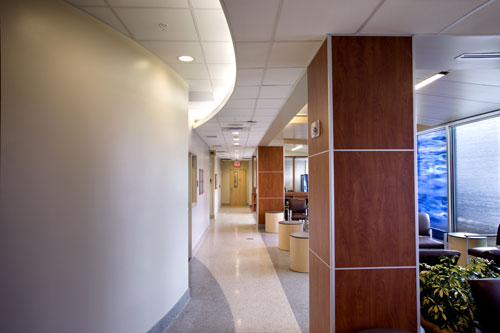 |
Noise reducing gypsum board can be used in a variety of settings to increase acoustic performance and enhance indoor environmental quality. Photo courtesy of CertainTeed Gypsum |
The effect of the transmitted sound on the receiver is the issue at hand. Hearing some sweet background noise may enhance an indoor environment. But more likely transmitted sounds will interfere with our daily activities like trying to talk on the phone, sitting in an examination room or conducting a class and thus reduce the indoor environmental quality. Part of the determination of this quality is the sound intensity or loudness as measured in decibels (dB) that can range from very faint to intolerable sound levels. The more intense the sound the higher the dB level with the corresponding higher detrimental impact on people.
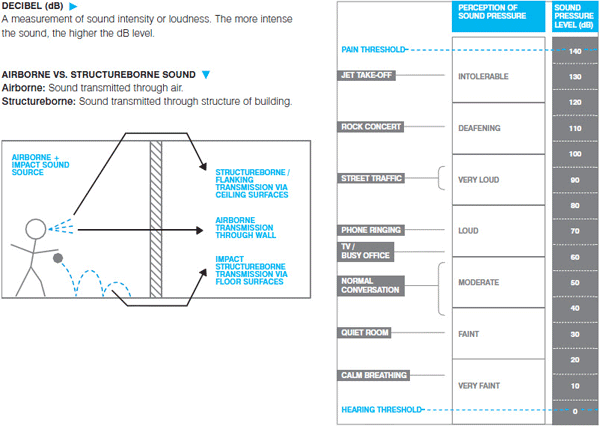 |
Airborne and structure borne sound is measured in decibels (dB or dBA) with varying levels having corresponding perceptions and impacts on people. Image courtesy of CertainTeed Gypsum |
There are four fundamental aspects of sound and its transmission that are used to address acoustical design and the impact on interior environmental quality within buildings. Each of these is discussed briefly below.
Ambient Noise
All background sound in a given environment, including sound from outdoors, building services and utilities is generally referred to as ambient noise. It can also be generated from people talking or functioning in adjacent indoor spaces. A certain amount of this ambient noise in the background is certainly commonplace, but excessive background noise can seriously degrade the ability to communicate, thus making it more difficult for people to hear and speak without raising their voices. It is generally accepted that most people would need to speak at least 15 dB louder than the ambient noise level in order to be heard at all. Therefore, what might otherwise amount to a moderate sound level for conversation (40 – 60 dB), can get bumped up into the loud sound range (60 -80 dB) by trying to overcome background noise that is already in the moderate range. Hence it is generally preferred that ambient noise is limited to less than 40 dB in a space where conversation or speaking is taking place.
Sound Transmission Class
With the acceptable ambient noise levels thus established the building designers need to focus on how to achieve them by restricting unwanted sound from entering the spaces being designed. This means creating wall, floor, and roof components or assemblies that first effectively block the amount of airborne sound transmitted through them. The measurement for this effectiveness is determined by a Sound Transmission Class (STC) rating. A higher STC rating means that more airborne sound is blocked by the component or assembly. Lower STC ratings mean that more sound passes through the components or assemblies adding to the background noise level in the space, thus degrading the ability to hear and understand speech.
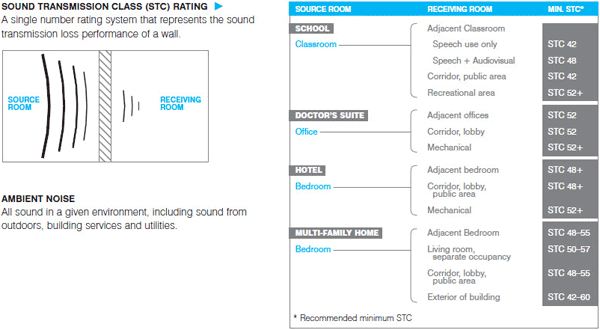 |
Sound Transmission Class (STC) ratings are one common and important measure of acoustical performance with different ratings appropriate to different occupancy types. Image courtesy of CertainTeed Gypsum |
It should be noted that, contrary to the popular notion that airborne sound passes through a structural element, such is not exactly the case. Sound generated on one side of a wall will energize the wall structure and set it in motion, much like a diaphragm. The wall itself becomes the transmitter of the sound energy which can be heard on the opposite side of the wall by the listener. Hence, the ASTM test methods used to determine STC ratings have focused on this direct transmission process. Currently, the STC number is derived from sound attenuation values tested at sixteen standard frequencies from 125 Hz to 4000 Hz. These transmission-loss values are then plotted on a sound pressure level graph and the resulting curve is compared to a standard reference contour. Acoustical engineers fit these values to the appropriate Transmission Loss curve (TL) to determine a final STC rating. The measurement is accurate for speech sounds but less so for amplified music, mechanical equipment noise, transportation noise or any sound with substantial low-frequency energy below 125 Hz. As a supplement to STC ratings, Outdoor-Indoor Transmission Class (OITC) is a standard used for indicating the rate of transmission of sound between outdoor and indoor spaces in a structure that considers frequencies down to 80 Hz (Aircraft /Rail /Truck traffic) and is weighted more to lower frequencies.
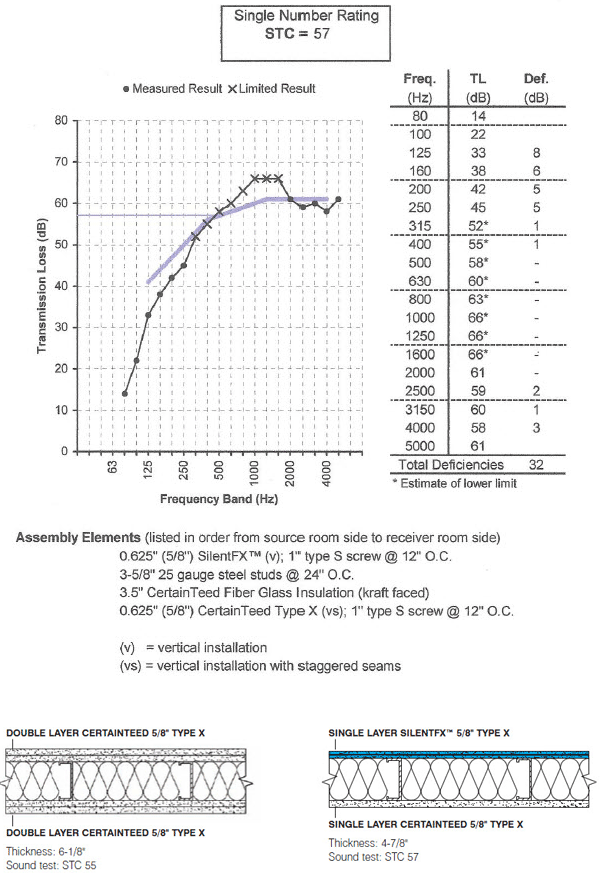 |
Actual test results show a single layer of 5/8” acoustical gypsum board achieves an overall STC rating of 57 compared to two layers of 5/8” gypsum board that achieves an STC rating of only 55 when all factors are equal. Images courtesy of CertainTeed Gypsum |
Impact Insulation Class
Beyond airborne sound, multi-story building designs need to address the resistance of structure borne sound, usually created by people walking or creating other impacts onto the floor/ceiling above a space. Similar to STC ratings which address airborne sound, floor/ceiling assemblies can be evaluated based on Impact Insulation Class (IIC) ratings. These IIC ratings reveal the ability of a floor-ceiling assembly to absorb or deflect impact/structure borne noise and keep it from being transmitted to the space below. A floor/ceiling assembly with a low IIC rating will allow distracting noise to be transmitted into the room below leading to the associated problems of distraction and hampered communication.
Reverberation Time and Speech Intelligibility
After the issue of ambient noise level is addressed by limiting the airborne and structure borne transmission of sound in a space, then the fourth significant aspect of acoustic design needs attention, namely Reverberation Time (RT). Sound reflections are created when noise reverberates and echoes around architectural spaces. RT is the acoustical concept which measures how long, in seconds, it takes for these echo noises to become inaudible. These echoes can impair what acoustical specialists call “speech intelligibility” since the echoes create garbled sounding words and impair verbal communication. Measuring Reverberation Time is important to determine the sound quality of speech and music in acoustical spaces. Instructional spaces, such as classrooms for example, are best with short RTs – less than 1 second to ensure clarity and high speech intelligibility. Speech generated in a space with a reverberation time of longer than 0.6 seconds is considered difficult to understand. Although some reverberation within a space can aide in speech distribution, longer reverberation times will cause a build-up of noise and thus degrade speech intelligibility. Auditoriums, theaters, and other musical spaces will typically benefit from longer RTs, typically greater than 1.5 seconds.
RT is determined by looking at both the room volume and sound absorption rate in an acoustical space. The volume of a space is proportional to the RT of that space; the greater the volume, the longer the RT. Inversely, the amount of sound-absorbing material in any space will have a negative effect on the RT. As an example, a large space with tiled floors and a gypsum board ceiling will have a long RT. Conversely, a small room with a low suspended ceiling and high-pile carpet will have a much shorter RT. The key is to find the right balance of noise reflective and absorptive surfaces for a particular interior space.
Directly related to RT is the amount of sound energy absorbed upon striking a particular surface. The more sound energy that is absorbed then the less that is reflected back as an echo or reverberation. The commonly used scale to record different levels of such sound absorption determined per the ASTM C 423 test method is a Noise Reduction Coefficient (NRC) which ranges from zero to one: an NRC of 0 indicates perfect reflection while an NRC of 1 indicates perfect absorption. In actuality, it is the average of four sound absorption coefficients of the particular surface at specific frequencies of 250 Hz, 500 Hz, 1000 Hz, and 2000 Hz. These are the typical frequencies of human speech, and, therefore, the NRC provides a standardized, simple quantification of how well the particular surface will absorb the human voice. A more broad frequency range should be considered for applications such as music or controlling mechanical noise. Acoustical materials manufacturers may report NRC values higher than 1.0 for highly absorptive materials such as fiberglass ceiling panels due to the way the number is calculated in a laboratory which does not account for diffraction effects caused by the sides of the test panel and can increase the sound absorption coefficients above 1.0. The Sound Absorption Average (SAA) is another single number rating of sound absorption defined in ASTM C 423 and it also ranges from 0.0 to 1.0. SAA is the arithmetic average of the sound absorption coefficients from 200 Hz to 2500 Hz and it is often reported along with the NRC for acoustical products.
Acoustic Control Through Noise Reducing Gypsum Board
Traditionally it has been common to design wall and ceiling/floor assemblies with a variety of layers and materials to achieve the desired STC and IIC ratings for a space. Installing sound deadening insulation like fiberglass between framing certainly helps and likely always will as long as it is installed properly. The use of multiple layers of gypsum board, sometimes installed over noise dampening resilient channels or isolation clips, was effective but often costly and time consuming. Any openings in the gypsum board for things like electrical outlets would be an obvious breach in the acoustic quality of any wall, prompting the common practice to offset their locations when installed back to back in framed walls or use putty pads to seal the outlet boxes.
 |
Noise reducing gypsum board is manufactured by using a viscoelastic polymer middle layer applied between two specifically formulated thin layers of gypsum board with the end product matching common gypsum board thicknesses of ½” or 5/8”. Photo courtesy of CertainTeed Gypsum |
Noise reducing gypsum boards are intended as a replacement for some of the traditional acoustic control methods on interior walls and ceilings in residential, commercial or institutional applications. They can be used for new construction or renovations over wood or steel framing. Assemblies that use a single layer of noise reducing gypsum board have been tested and shown to meet or exceed the acoustic performance of assemblies that use double layers of traditional gypsum board. This makes it quite effective in situations where acoustic management is needed to dampen sound energy and significantly improve sound attenuation through walls and ceilings. These results are achieved through the manufacture of a single panel product that contains a viscoelastic polymer middle layer applied between two specifically formulated thin layers of gypsum board. The final product ends up being ½ - 5/8” thick or the same as traditional gypsum board thicknesses. This building product has the ability to dampen sound transmission caused by sound energy striking it by using the inner polymer layer as a kind of shock absorber that dampens board vibrations. This type of “constrained layer damping” board product performs well acoustically over an extended range of frequencies, resulting in increased Sound Transmission Class (STC) ratings for the systems.
Noise reducing gypsum board is thus an excellent acoustic solution for meeting STC specifications without complex techniques such as isolation clips or resilient channels. Clips and resilient channel can easily be short-circuited during the construction process. They can also be compromised afterwards, during picture hanging or pressing of heavy objects against the wall which will negatively affect acoustic performance. These risks are eliminated when using noise reducing gypsum board directly applied to framing thus providing more consistent and predictable acoustic performance. Note that noise reducing gypsum board can still be used in wall assemblies where resilient channels or clips are desired to achieve extra sound transmission control. In this case, the material helps reduce the negative effect of any short circuits.
Using single layer noise reducing gypsum board can also help reduce material usage versus traditional multi layered gypsum systems that might be otherwise required to achieve high sound attenuation. The high acoustic performance of the product makes it possible to build effective noise-reducing walls with less material, gaining valuable square footage, and saving both construction time and material cost. Less material used also means a more sustainable structure in keeping with green building practices.
ACOUSTICS IN SCHOOLS
Effective learning depends on effective communication between teachers and students. It has been established by a number of experts, and certainly some common sense, that excessive noise creates a barrier to effective learning. Ambient noise in schools such as conversations in hallways, sound systems, students in other classrooms and mechanical equipment can hamper student concentration and interfere with student/teacher communications. And background noise causes teachers to raise their voices, which results in vocal strain over time.
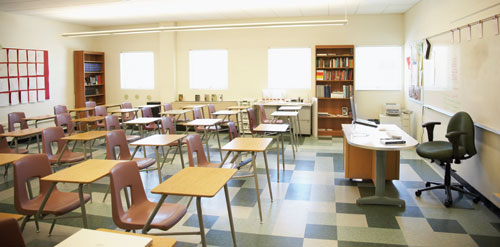 |
Good acoustics in school settings contribute to overall indoor environmental quality, improve learning outcomes, and reduce the need for teachers to raise their voices to be heard. Photo courtesy of CertainTeed Gypsum |
The US Green Building Council (USGBC) has been a strong leader for the promotion of highly sustainable school environments through the LEED ® for Schools Program. Within that specialized version of the LEED ® rating system, acoustic performance is a specific criterion in two cases. First, there is mandated Prerequisite 3 – “Minimum Acoustical Performance. The stated intent of this pre-requisite is “To provide classrooms that are quiet so that teachers can speak to the class without straining their voices and students can effectively communicate with each other and the teacher.” While it would seem to many that this is a basic and commonly achieved criteria, the built condition in many school buildings indicates otherwise. Beyond the basic pre-requisite requirement, there is also an additional IEQ Credit 9 – “Enhanced Acoustical Performance”. The stated intent of this credit is “To provide classrooms that facilitate better teacher-to-student and student-to-student communications through effective acoustical design.” In other words, it acknowledges the design efforts of improving acoustical design beyond the minimum pre-requisite level to achieve better environments for speech communication and education.
The basis for demonstrating compliance with the LEED® for schools acoustic performance requirements is ANSI Standard S12.60-2002, “Acoustical Performance Criteria, Design Requirements and Guidelines for Schools”. This national standard has been used independently as a basis for determining currently acceptable levels of acoustic performance in schools. It addresses all aspects of acoustical design beginning with the establishment of some very stringent thresholds for background or ambient noise. Specifically, for core learning spaces of 20,000 cubic feet or less, the one-hour steady-state background noise levels should not exceed 35 dBA, while those over 20,000 cubic feet should not exceed 40 dBA. This is the same “faint” level of sound that one would experience in a quiet office. There is a caveat however that if the noisiest one-hour period during which learning activities take place is dominated by transportation noise, these maximum noise limits can each be increased by 5 dB. The LEED prerequisite requirements follow these same ANSI thresholds for size and dB levels of background noise, although it is only stated to address HVAC equipment noise.
In terms of isolating noise through STC ratings, the ANSI standard is quite prescriptive. It lists minimum STC ratings for single or composite wall, floor/ceiling and roof/ceiling assemblies that separate an enclosed core learning space (e.g. classrooms) from an adjacent space. These ratings vary from STC 45 – 60 depending on the nature of the adjacent space. For example STC 45 is acceptable between classrooms and corridors, but STC 50 is required between other core learning spaces between a classroom and the outdoors. If the core learning space is adjacent to a toilet room or bathing room, the requirement bumps up to STC 53. And, not surprisingly, if the core learning space is adjacent to a larger, louder space such as a music room, equipment room, cafeteria, pool, etc., then the minimum acoustical performance standard is STC 60. There are similar ratings for ancillary learning spaces as opposed to core learning spaces, which are slightly relaxed compared to the ones listed above, but they are dependent on the nature and use of the adjacent space.
Standard S12.60-2002 goes on to identify specific Impact Insulation Class ratings and recommendations for classroom learning spaces including the following:
- IIC ratings for floor-ceiling assemblies above core learning spaces should be at least IIC-45 and preferably IIC-50 as measured on floors without carpeting.
- In new construction, a gymnasium, dance studio, or other spaces with high floor impact activities shall not be located above core learning spaces.
- In existing facilities IIC-65-70 (depending on the volume of the space below) is recommended if gymnasia, dance studios or other spaces with high floor impact activities are located above core learning spaces.
Finally, the standard addresses Reverberation Time by acknowledging that it is possible to calculate the reverberation time of sound within a space based on the interior surface qualities of a room. Using the process identified in ANSI S12.60-2002 to conduct these calculations, the resulting educational spaces must meet the following levels in order to comply:
- The maximum reverberation time for core learning spaces with internal volumes of greater than 10,000 cubic feet should not exceed 0.6 seconds.
- For core learning spaces with internal volumes of more than 10,000 but less than 20,000 cubic feet the maximum reverberation time is 0.7 seconds.
- Reverberation time for spaces with more than 20,000 cubic feet of internal volume is not specified, however, guidelines are given in Annex C of the standard.
If an existing space or room is being investigated, then it can be tested with acoustical equipment specifically intended for measuring RT. For a new space, calculations must be relied on to determine what the RT will be in the proposed space.
Noise reducing gypsum board can be used to contribute to the acoustical performance in all of these aspects and demonstrate compliance with LEED® for Schools and ANSI Standard S12.60-2002. It specifically reduces sound transmission from adjacent spaces to make it easier for teachers to be heard and students to learn. As a result, it reduces distractions so students can pay closer attention and learn more effectively while keeping the lines of communication between students and teachers clear and open. For teachers, it reduces voice strain and increases the effectiveness of their teaching.
ACOUSTIC GUIDELINES FOR HEALTH CARE FACILITIES
Healthcare facilities need to provide an oasis of quiet that is conducive to healing. They are also under pressure to reduce costs and be more responsive to patients. In hospitals that are designed and constructed with reduced noise levels, patient satisfaction with caregiving is increased and sleep is improved. This can lead to faster healing which can mean shorter stays and reduced costs for both patients and hospitals.
 |
Health care facilities find many benefits to their indoor environment through better acoustical control that result in better patient experiences and reduced hospital stays. Photos courtesy of CertainTeed Gypsum |
In recognition of the interior impact of sound control in hospitals and health care facilities, a draft set of Sound and Vibration Design Guidelines for Health Care Facilities has been developed under the auspices of ANSI and the Acoustical Society of America. January 1, 2010. Even though it is still in development, it has already been designated as the sole Reference Standard for acoustics by the Facility Guidelines Institute (FGI) with a mission of promoting consensus based guidelines, advised by research, to advance quality health care. LEED® 2009 for Healthcare also relies on this standard to demonstrate performance and earn up to 2 acoustic credits. The standard itself includes design guidelines for sound isolation between various types of rooms.
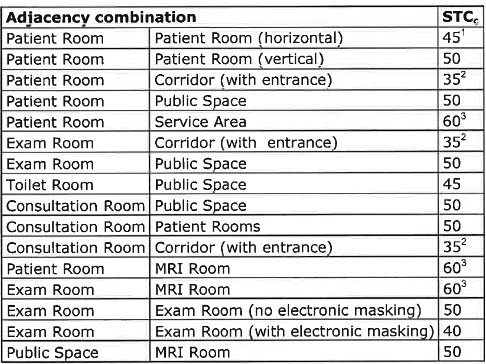 |
The emerging standard, Sound and Vibration Design Guidelines for Health Care Facilities identifies specific STC ratings between common health care spaces that are adjacent to each other. Image courtesy of CertainTeed Gypsum |
The benefits of incorporating this aspect of indoor environmental quality in health care facilities include the ability to improve patients’ sleep which can directly influence shortening healing time leading to reduced costs for the facility. From a hospital employee perspective, it can increase staff job satisfaction, which can reduce turnover of employees. Within the realm of hospital and health care facility administration, it helps meet HIPAA acoustic privacy regulations.
ACOUSTICS IN THE INTERNATIONAL GREEN
CONSTRUCTION CODE (IGCC)
The International Green Construction Code (IgCC) is a comprehensive code released in 2012 by the International Code Council (ICC) for adoption by jurisdictions around the country. The IgCC is the first model code that includes sustainability measures for an entire design and construction project and its site. This new code is expected to make buildings more energy and material efficient, reduce waste, and have a positive impact on the health, safety and welfare of building occupants and the community. By creating a regulatory framework for new and existing buildings it establishes minimum green requirements for buildings and complementary voluntary rating systems. The code acts as an overlay to the existing set of International codes authored and distributed by the ICC. Acoustics are specifically addressed in the IgCC in Section 807 and focus on a variety of conditions and elements that are similar to other standards. Where the local code authorities have indicated that Section 807 is enforceable, the sound transmission levels must be limited in accordance with the STC / IIC criteria provided for specific areas of the building as follows:
- Interior Sound Transmission: The code addresses separation between tenants or different occupancies in a building as identified in the International Building Code. For example, wall and floor/ ceiling assemblies that separate Group A (Assembly) and F (Factory) occupancies from one another or between Group B (Business), I (Institutional), M (Mercantile) or R (Residential) occupancies must achieve an STC rating of not less than 60. It also allows for field testing as an alternative to factory testing, but adjusts the requirement by referring to it as an Apparent Sound Transmission Class (ASTC) rating and requiring a value of not less than 55 in this case. Wall and floor/ceiling assemblies that separate Group B, I, M or R occupancies from one another shall have an a less restrictive STC rating of not less than 50 or an ASTC of not less than 45 if the completed construction is field tested. These ratings increase if a Group R condominium occupancy is involved to an STC of 55 or and ASTC of 50.
-
Background Sound Levels: Sound generated from mechanical and electrical equipment must be isolated in rooms where the walls and floor/ceiling assemblies achieve a minimum STC rating of 50 (or ASTC of 45). Rooms that contain emergency generators must achieve an STC rating of 60 (or ASTC of 55) although electrical generators used only for emergencies are exempt from limits on sound levels. The overall intent of this isolation is to produce background noise levels in adjacent rooms that do not create a detrimental acoustical interior environment. Accordingly, the code establishes maximum noise criteria (NC) limits, measured in decibels, both for outdoor spaces and for different types of rooms within a building. Generally, these limits fall within the faint to moderate levels of background noise thus establishing a minimum threshold for acoustical code compliance.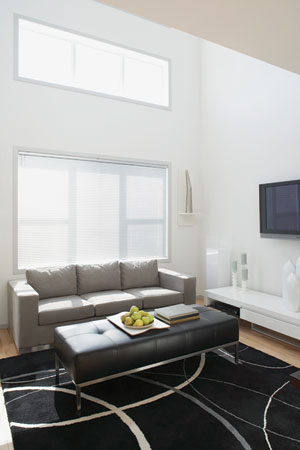
Good acoustical design is specifically addressed in dwelling units in the International Green Construction Code.
Photo courtesy of CertainTeed Gypsum
- Structure Borne Sound: The code addresses structure borne sound specifically as it applies to floor and ceiling assemblies in dwelling rooms or dwelling units. Hence any dwelling rooms or dwelling units that share a floor or ceiling assembly with another dwelling room or unit or with a public or service area within the structure must achieve an IIC rating of not less than 50 where laboratory tested and 45 where field-tested in accordance with ASTM E 492. Note that this requirement applies to dwelling rooms or units in building occupancies classified as Group Al, A2, A3, B, E, I, M or R.
- Special Inspections: In order to verify that the acoustical performance called for under the IgCC is achieved, an approved agency, funded by the building owner, must furnish report(s) of test findings indicating that the sound level results are in compliance with section 807 of the code and the construction documents. Discrepancies must be brought to the attention of the design professional and to the code official prior to the completion of work.
SUSTAINABLE MATERIAL CHOICES FOR ACOUSTICAL TREATMENTS
Sustainability and green principles are clearly important in all material selections, particularly if LEED® for Schools or Healthcare is being pursued. It is also important in other settings as well such as multi-family housing or general building construction. Clearly, maintaining the integrity of the green principles of the building means addressing all of the materials in the building, including the acoustical treatments. Therefore, beyond the acoustic qualities, the following should be considered:
- Selecting materials with recycled content. Acoustical treatments do not need to be manufactured from virgin raw materials. In fact noise reducing gypsum board will often have recycled content. It is possible and quite desirable to specify the face and back paper used for boards consisting of up to 100% recycled paper. Additionally, synthetic or “by-product” or DSG gypsum produced from the desulphurization of flue gases at coal-fired power plants is used where sources are available. The total recycled content for these synthetic gypsum plants is up to 96%. And most manufacturers assure that in-plant scrap is recycled back into the process.
- Reducing construction waste. Materials that are easy to work with and can be readily installed into the building should produce less waste. Converting to single layer noise reducing gypsum board instead of double layer traditional gypsum board means that less material is being used and less waste is generated.
- Selecting regional materials. This item is obviously dependent on the location of the building and the source of materials so it will not be possible for all projects. Nonetheless, gypsum board manufacturing locations provide regional material coverage throughout North America and should be eligible for regional materials in many locations.
- Indoor environmental quality contributions. We have been covering the acoustical qualities in some detail, but there are other considerations to take into account with noise reducing gypsum board. Specifically, moisture and mold resistant face and back paper also contribute to indoor air quality by providing enhanced moisture and mold resistance.
- Innovation in green design. Using some of the acoustic principles discussed previously, it is quite possible to exceed the stated minimums for acoustic performance and be recognized for innovation credit. It may also be possible to show the synergistic capabilities of noise reducing gypsum board in a particular building to demonstrate innovations in design.
SPECIFYING NOISE REDUCING GYPSUM BOARD
In writing specifications for noise reducing gypsum board, the first thing to determine is the needed sound rating for the assemblies incorporated into the building and design them accordingly, Then the following options can be considered.
- Thickness: 1/2" or 5/8" Type X
- Widths: 4'; Lengths: 8’ or custom
- Edges: Tapered
- Product Standards: ASTM C 1396, ASTM C 1629
 |
Noise reducing gypsum board is installed and finished in the same manner as conventional gypsum board. Photo courtesy of CertainTeed Gypsum |
Noise Reducing Gypsum Board is installed following traditional methods of application and finishing of interior gypsum board products for both walls and ceilings, but with a little more attention to detail to insure acoustic performance. First the board layout should be planned to stagger joints from one side of the wall to the other. Next, sound insulating fiberglass batts need to be installed in cavities for higher STC ratings where needed. Note that resilient channels are typically no longer needed to achieve performance except in very acoustically sensitive situations. It is appropriate to specify putty pads (tested per ASTM E 90) or acoustical sealant to seal electrical outlets, however.
Panels of noise reducing gypsum board should be installed in accordance with GA-216, “Application and Finishing of Gypsum Panels” (ASTM C 840) and the manufacturers’ application instructions. Best practices indicate to allow a 1/4" (6 mm) gap around all wall perimeter edges for any movement. Noise reducing gypsum boards are typically cut the same as other gypsum board by deeply scoring from both sides and snapping. Cutting across 4' width may require use of a hand or power saw. Specify to seal the 1/4" perimeter gaps and wall penetrations per ASTM C 919 with acoustical sealant.
Noise reducing gypsum board may be finished, painted or wallpapered using conventional gypsum board techniques. The Gypsum Association publication GA-214, “Recommended Levels of Gypsum Board Finish,” should be referenced when specifying the level of finishing desired.
CONCLUSION
Noise reducing gypsum board uses an innovative polymer layer that dampens sound energy when located between two gypsum boards with specially formulated, dense cores. These boards are enclosed in recycled moisture and mold resistant face and back papers that offer an economical single layer alternative to multi-layer gypsum board in wall and ceiling assemblies. The result of this combination is improved sound attenuation for high STC systems in a variety of building settings, distinct contributions to green building design, and direct contributions to compliance with emerging standards of acoustics as part of indoor environmental quality.
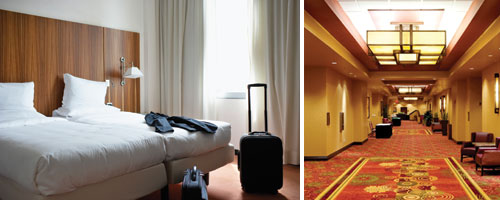 |
Noise reducing gypsum board used in hospitality settings helps assure privacy and greater guest comfort. Photos courtesy of CertainTeed Gypsum |
 |
CertainTeed Gypsum offers a wide range of gypsum and finishing products for interior and exterior needs, providing architects, contractors, builders and dealers service and support for commercial and residential building projects. www.certainteed.com |
